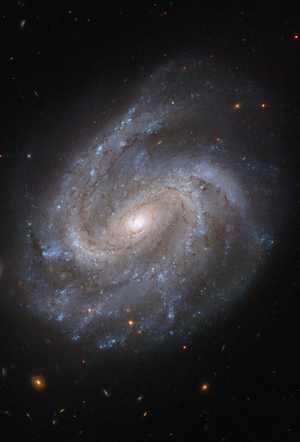NGC 201
| Galaxie NGC 201 | |
|---|---|
(c) ESA/Hubble, CC BY 4.0 | |
| Aufnahme des Hubble-Weltraumteleskops | |
| AladinLite | |
| Sternbild | Walfisch |
| Position Äquinoktium: J2000.0, Epoche: J2000.0 | |
| Rektaszension | 00h 39m 34,8s[1] |
| Deklination | +00° 51′ 36″[1] |
| Erscheinungsbild | |
| Morphologischer Typ | SAB(r)c[1] |
| Helligkeit (visuell) | 12,9 mag[2] |
| Helligkeit (B-Band) | 13,6 mag[2] |
| Winkelausdehnung | 1,8′ × 1,5′[2] |
| Positionswinkel | 155°[2] |
| Flächenhelligkeit | 13,8 mag/arcmin²[2] |
| Physikalische Daten | |
| Zugehörigkeit | HCG 7, LGG 10[1] |
| Rotverschiebung | 0.014583 ± 0.000006[1] |
| Radialgeschwindigkeit | (4372 ± 2) km/s[1] |
| Hubbledistanz H0 = 73 km/(s • Mpc) | (199 ± 14) · 106 Lj (61,1 ± 4,3) Mpc [1] |
| Durchmesser | 105.000 Lj[3] |
| Geschichte | |
| Entdeckung | Wilhelm Herschel |
| Entdeckungsdatum | 28. Dezember 1790 |
| Katalogbezeichnungen | |
| NGC 201 • UGC 419 • PGC 2388 • CGCG 383-059 • MCG +00-02-115 • IRAS 00370+0035 • 2MASX J00393485+0051355 • HCG 7C • GC 102 • H III 873 • h 43 • LDCE 0034 NED008 | |
NGC 201 ist eine Balken-Spiralgalaxie vom Hubble-Typ SAB(r)c im Sternbild Walfisch südlich des Himmelsäquators. Sie ist schätzungsweise 199 Millionen Lichtjahre von der Milchstraße entfernt und hat einen Durchmesser von etwa 105.000 Lj. Gemeinsam mit NGC 192, NGC 196 und NGC 197 bildet sie die Hickson-Kompaktgruppe HCG 7.
HCG steht für Hickson Compact Group. Dabei handelt es sich um Ansammlungen von hellen Galaxien, die vergleichsweise isoliert liegen. Man nimmt an, dass die Galaxien der HCG 7 sich nähern und schließlich miteinander verschmelzen werden.[4] Simulationen haben gezeigt, dass diese Galaxien innerhalb von einer Milliarde Jahren eine riesige Galaxie bilden werden.
Das Objekt wurde am 28. Dezember 1790 von dem deutsch-britischen Astronomen Wilhelm Herschel entdeckt.[5]
Weblinks
Einzelnachweise
Auf dieser Seite verwendete Medien
(c) ESA/Hubble, CC BY 4.0
Discovered by astronomer William Herschel in the late 1700s, NGC 201 is a barred spiral galaxy similar to our own galaxy, the Milky Way. It lies 200 million light-years from Earth in the constellation of Cetus (The Sea Monster), and is invisible to the naked eye.
This new NASA/ESA Hubble Space Telescope image of NGC 201 shows the galaxy in striking detail, capturing the bright centre and the barred spiral arms — arms that do not start directly from the galactic centre, but instead seem to be offset and stem from a "bar" of stars cutting through the middle of the galaxy.
Along with three of its closest galactic neighbours (outside the frame), NGC 201 belongs to a group known as the HCG 7 compact galactic group. Hickson Compact Groups (HCG) are relatively small and isolated systems containing a handful of bright, compact galaxies that lie close to one another. As the galaxies within these groups move closer together they interact strongly, dragging galactic material out into space and distorting the structure of the other group members.
Eventually, all the galaxies within one HCG will merge together. Simulations have shown that within a billion years, the galaxies within one HCG have merged to form a giant fossil galaxy. It is possible that this is the final fate of all galactic groups.
A version of this image was submitted to the Hubble's Hidden Treasures image processing competition by contestant Luca Limatola.
About the Object
Name: HCG 7, NGC 201
Type: • Local Universe : Galaxy : Type : Spiral
• Local Universe : Galaxy : Type : Barred
• Local Universe : Galaxy : Grouping : Multiple
• X - Galaxies Images/Videos
Distance: 200 million light years
Colours & filters Band Wavelength Telescope Optical B 435 nm Hubble Space Telescope ACS Optical V 606 nm Hubble Space Telescope ACS Infrared I 814 nm Hubble Space Telescope ACS.

